PM² is a Project Management Methodology developed by the European Commission. Its purpose is to enable Project Managers (PMs) to deliver solutions and benefits to their organizations by effectively managing the entire lifecycle of their project. PM² has been created with the needs of European Union institutions and projects in mind, but is transferrable to projects in any organization. PM² Guide includes:
- Project Governance Model: roles and responsibilities.
- Project Lifecycle: project phases.
- Set of Processes: project management activities.
- Set of Project Artefacts: templates and guidelines.
- Set of Mindsets: effective beliefs and behaviors.
OpenPM² is a free version of the PM² developed by the European Commission in 2007. It incorporates elements from globally accepted best practices, standards and methodologies. OpenPM² gives open access to the PM², widening the circle of beneficiaries across Europe and enriching the methodology with additional good practices and examples. It aims to improve project management competency in the EU.
OpenPM² offers these resources for free:
- PM² Guide – Open Edition: download pdf file (https://bit.ly/download_pm2_guide_v3)
- PM² Artefacts: download .rar file with document templates (https://bit.ly/download_pm2_templates)
- PM² Online resources (wiki)
- A Project Support Network (PSN): a network/community of PM² users that can support each other in rolling-out PM² in their organizations, and with using the PM² methodology in their projects.
European Union’s Project Management Methodology PM² is based on roles from the requestor and provider side of the project. PMPeople can be the tool to implement this methodology on projects funded by the EU, as well as projects in any organization.
Introduction to PM²
PM² project governance model separates project management in two sides:
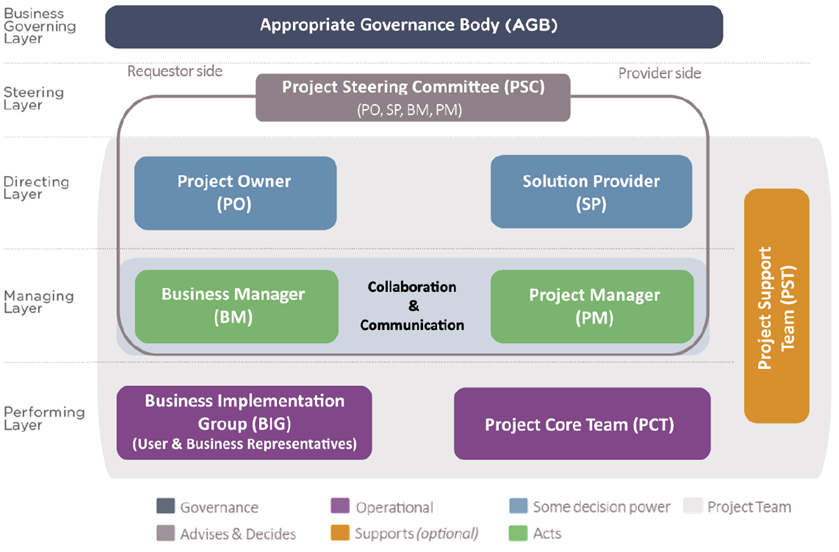
- Requestor Side, also referred to as the Client Side, includes the roles belonging to the requestor organization where the solution will be delivered, such as the Project Owner (PO), the Business Manager (BM) and Business Implementation Group (BIG).
- Provider Side includes the project roles that develop and implement the solution, i.e. the Solution Provider (SP), the Project Manager (PM) and the Project Core Team (PCT).
PM² follows a project lifecycle model with four phases :
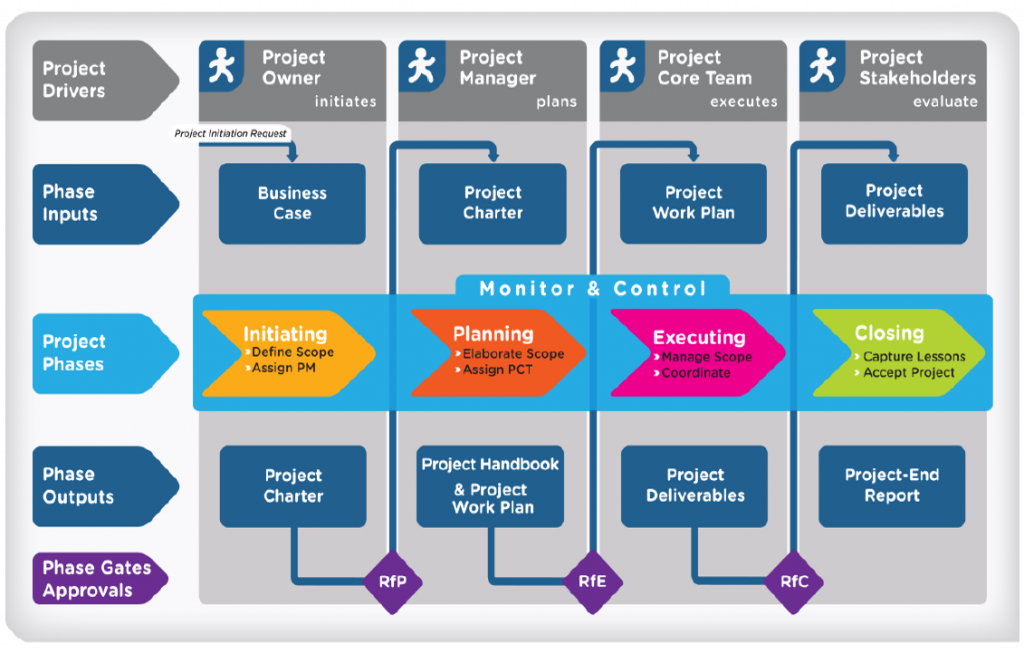
- Project Phases are: initiating, planning, executing and closing.
- Phase Outputs are: Project Charter, Project Handbook, Project Work Plan, Project Deliverables and Project End Report.
- Phase Gates Approvals are named as: Request for Planning (RfP) to move from initiating to planning phase,Request for Execution (RfE) to move from planning to executing phase, and Request for Closing (RfC) to move from executing to closing phase.
For each phase and also for the processes of monitor and control, the guide describes a series of activities to be performed by certain roles, to produce certain artefacts:

PM² Roles
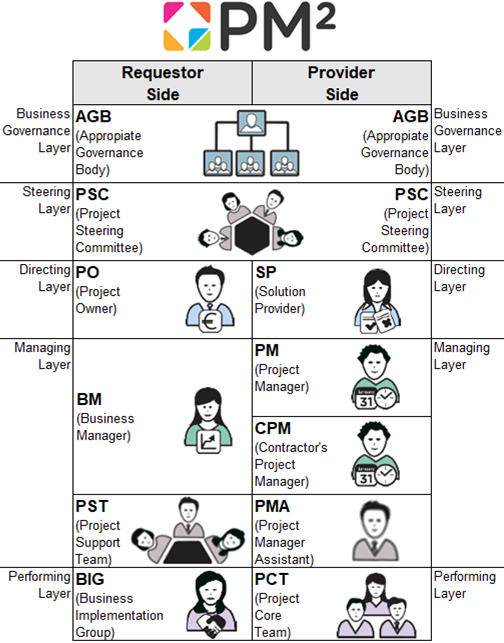
Appropriate Governance Body (AGB)

The Appropriate Governance Body (AGB) is the entity responsible for the strategic planning and portfolio management. In terms of projects, this is the body with the authority to approve a project, agree its stated objective and release the funding required to implement it. As a key decision-making body, this group comprises members from the requestor and provider side of the project. This role:
- Defines the corporate and business domain strategy.
- Agrees to and implements a portfolio management framework to achieve the strategic objectives.
- Identifies, evaluates and authorizes programs and projects for implementation.
- Monitors and controls portfolio delivery performance.
- Optimizes and manages portfolio resources and benefits.
Project Steering Committee (PSC)

The Project Steering Committee (PSC) comprises the necessary roles to meet the project management goals, providing a balanced mix of requestor and provider side representatives. This role:
- Champions the project and raises awareness of it at a senior level.
- Guides and promotes the successful execution of the project at a strategic level, keeping the project focused on its objectives.
- Ensures adherence to the organization’s policies and rules (e.g. IT governance, data protection, information security, document management, etc.).
- Provides high-level monitoring and control of the project.
- Authorizes transition between Phases, unless this is performed by the Appropriate Governance Body (AGB).
- Authorizes deviations and scope changes with a high project impact and has the final say on decisions.
- Deals with escalated issues and conflicts.
- Drives and manages organizational change related to the project’s outcomes.
- Approves and signs off key management milestone artefacts (i.e. Project Charter, Project Work Plan).
Project Owner (PO)

The Project Owner (PO) is the client of the project, and as such sets the business objectives and ensures that project outcomes are in line with business objectives and priorities. The Project Owner (PO) is accountable for the overall project’s success, and later becomes the owner of the project’s outputs (product or service). This role:
- Acts as the project champion, promoting the project’s success.
- Chairs the Project Steering Committee (PSC).
- Provides leadership and strategic direction to the Business Manager (BM) and Project Manager (PM).
- Sets the business objectives and accepts the Business Case for the project.
- Owns the business risks and ensures that project outcomes are in line with business objectives and priorities.
- Mobilizes the resources necessary for the project from the requestor side, in accordance with the agreed budget.
- Regularly monitors project progress.
- Coordinates the resolution of escalated issues and conflicts.
- Drives organizational change and monitors proper evolution and change implementation.
- Approves and signs-off on key management milestone artefacts (Business Case, Project Charter, Project Handbook, Project Management Plans, Business Implementation Plan, etc.)
Business Manager (BM)

The Business Manager (BM) represents the Project Owner (PO) on a daily basis within the project and helps in defining the project’s business objectives via the Project Initiation Request, Business Case and Business Implementation Plan. The Business Manager (BM) collaborates closely with the Project Manager (PM) and coordinates client-side activities and roles (e.g. user and business representatives), ensuring that the project’s deliverables fulfil the business and user needs. This role:
- Guarantees cooperation and an efficient communication channel with the Project Manager (PM).
- Coordinates the Business Implementation Group (BIG) and acts as a liaison between the User Representatives (URs) and the provider organization.
- Ensures that the products delivered by the project fulfil the user’s needs.
- Manages the activities on the business side of the project and ensures that the required business resources are made available.
- Decides on the best way to introduce business change or re-engineering actions, when needed.
- Ensures that the business organization is ready to accommodate the project’s deliverables when they are made available by the Solution Provider (SP).
- Leads the implementation of the business changes within the user community.
- Coordinates the schedule and delivery of any user training (and production of related material).
Project Support Team (PST)

The Project Support Team (PST) is an optional role that consists of the people responsible for providing support to the project. Its composition and structure depend on the needs of the project. The Project Support Team (PST) is often composed of representatives from various horizontal services or units. This role:
- Provides administrative support to the project.
- Defines requirements for reporting and communication.
- Administers Project Steering Committee (PSC) meetings and drafts related reports.
- Supports the Project Manager (PM) in planning, monitoring and controlling the project.
- Advises on project management tools and administrative services.
- Manages the project documentation (versioning, archiving, etc.).
Business Implementation Group (BIG)

The Business Implementation Group (BIG) sits on the requestor side and consists of representatives of business and user groups. Coordinated by the Business Manager (BM), it is responsible for planning and implementing the business changes that need to be made for the organization to effectively integrate the project deliverables into its everyday work. This role:
- Analyses the impact of the project’s implementation on ongoing operations, existing business processes, staff and organizational culture.
- Participates in the design and updating of affected business processes.
- Prepares the affected business area for the upcoming change.
- Advises the Business Manager (BM) on the organization’s readiness for change.
- Embeds the project deliverables into business operations and implements the organizational change activities that fall within the project’s scope.
Solution Provider (SP)

The Solution Provider (SP) assumes overall accountability for project deliverables and represents the interests of those who design, manage and implement (or outsource) the project’s deliverables. The Solution Provider (SP) usually has a management position in the functional hierarchy of the organization undertaking the project, and therefore often works with the Project Owner (PO) in defining the project’s business objectives. This role:
- Assumes overall accountability for the project deliverables and services requested by the Project Owner (PO).
- Mobilizes the required resources from the provider side and appoints the Project Manager (PM).
- Approves the objectives of any outsourced activities and deliverables and becomes accountable for the contractor’s performance.
Project Manager (PM)

The Project Manager (PM) oversees the project on a daily basis and is responsible for delivering high quality results within the identified objectives and constraints, ensuring the effective use of the allocated resources. More widely, the Project Manager’s (PM) responsibility also includes risk and issue management, project communication and stakeholder management. This role:
- Executes the project plans as approved by the Project Steering Committee (PSC).
- Coordinates the Project Core Team (PCT), ensuring the effective use of the allocated resources.
- Ensures that project objectives are achieved within the identified constraints, taking preventive or corrective measures where necessary.
- Manages stakeholder expectations.
- Oversees the creation of all management artefacts (except the Project Initiation Request, Business Case and Business Implementation Plan) and secures approval from the Project Owner (PO) or the Project Steering Committee (PSC).
- Ensures the controlled evolution, of products delivered, through proper change management.
- Performs risk management activities for project-related risks.
- Monitors project status and reports to the Project Steering Committee (PSC) on project progress at regular predefined intervals.
- Escalates unresolvable project issues to the Project Steering Committee (PSC).
- Liaises between the directing and performing layers of the project.
Contractor’s Project Manager (CPM)

The Contractor’s Project Manager (CPM) leads the contractor’s staff working on the project, planning controlling and reporting on the production of outsourced deliverables. Working closely with the Project Manager (PM), the Contractor’s Project Manager (CPM) ensures that all work is carried out on time and to the agreed standards, guaranteeing the successful completion and delivery of subcontracted activities.
Project Manager Assistant (PMA)

For large projects, the Project Manager (PM) might find it useful to delegate some management tasks to an assistant. This Project Management Assistant (PMA) can work on a range of coordination and supportive tasks as assigned by the Project Manager (PM), and acts as the Project Manager’s (PM) backup in meetings, etc. However, the Project Manager (PM) remains the person responsible for all project management tasks and deliverables. The Project Management Assistant (PMA) may also be part of a Project Support Team (PST) and assigned to the project.
Project Core Team (PCT)

The Project Core Team (PCT) comprises the specialist roles responsible for creating the project deliverables. Its composition and structure depend on the project size and type (e.g. IT project, policy development project, etc.) and is defined by the Project Manager (PM) based on the project’s needs. This role:
- Participates in developing the project scope and planning project activities.
- Carries out project activities based on the Project Work Plan and schedule.
- Produces project deliverables.
- Provides the Project Manager (PM) with information on the progress of activities.
- Participates in project meetings as needed and helps resolve issues.
- Participates in the Project-End Review Meeting during the collection of Lessons Learned.
PM² Implementation with PMPeople
PMPeople supports the 11 collaborative roles to manage projects professionally. As in PM², these roles are separated in 2 sides: project demand management (the requestor side) versus project supply management (the provider side).
Next table shows how PMPeople roles match PM² ones:
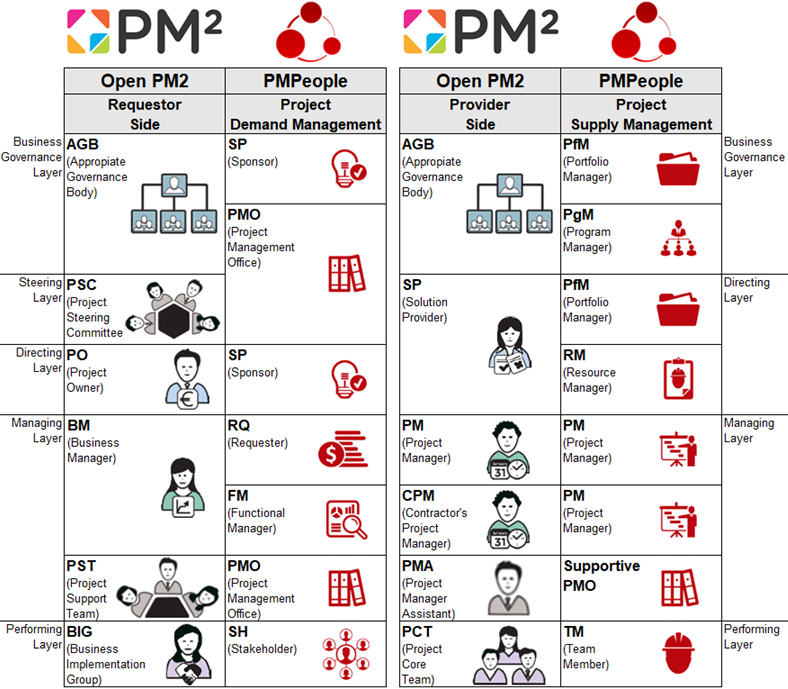
Find PMPeople roles definitions below.
Demand Management Roles
Stakeholder (SH)

Project Stakeholders are the people who may affect, be affected by, or perceive themselves to be affected by decisions, activities, or outcomes of projects. Stakeholders are on the demand side because they need to monitor project performance to make sure it will meet their expectations.
Requester (RQ)
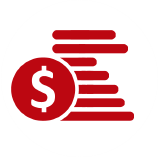
Project Requesters are the people who ask for new projects inside the performing organization. They work to get projects approved, follow progress and collaborate to get it done. Requesters are on the demand side because they need to monitor project performance to make sure it will meet the business goals.
Sponsor (SP)

Project Sponsors are the people who provide resources and support for the project, and are accountable for enabling success. Sponsors are on the demand side because they need to monitor project performance to guide strategic decisions.
Functional Manager (FM)

Functional Managers are the people with management authority over a Business Unit (BU). Any project belongs to one BU –if several BUs collaborate on the same project, one of them should be leading. Functional Managers are on the demand side because they need to monitor project financial performance, mainly.
Project Management Office (PMO)

People inside the Project Management Office (PMO) are the people who standardizes the project-related governance processes and facilitates the sharing of resources, methodologies, tools, and techniques. PMO people are on the demand side because they need to initiate projects and then monitor project performance. PMO role can see all projects and resources inside the organization. PMO has access to all features available for PM on each project, but also some other specific features.
Supportive PMO (PMOS)

PMOS are the people who provide a consultative role and assist project managers on their day to day activity, especially those related to data recording and reporting. PMOS are on the demand side because, for the purposes or the PPM tool, they can do the same functions as the PMO role, but only for the projects they assist.
Supply Management Roles
Portfolio Manager (PfM)

Portfolio Managers are the people assigned by the performing organization to establish, balance, monitor, and control portfolio components in order to achieve strategic business objectives. A portfolio refers to a collection of projects, programs and other work that are grouped together –usually to deliver a solution– to facilitate effective management of that work to meet strategic business objectives. Portfolio Managers are on the supply side because they are accountable for strategic plan execution and strategic goals achievement.
Program Manager (PgM)

Program Managers are the people authorized by the performing organization to lead the team or teams responsible for achieving program objectives. A program is defined as a group of related projects –usually to improve a product– managed in a coordinated way to obtain benefits and control not available from managing them individually. Program Managers are on the supply side because they are accountable for benefit delivery throughout the whole lifecycle of the program or product.
Project Manager (PM)
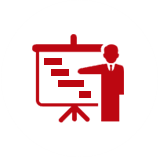
Project managers are the people are the people assigned by the performing organization to lead the team that is responsible for achieving the project objectives. A project is a temporary endeavor undertaken to create a unique product, service, or result. Projects can be managed individually or grouped by programs or portfolios. Any project belongs to one Business Unit –if several BUs collaborate on the same project, one of them should be leading. Project Managers are on the supply side because they are accountable for the project conclusion achieving the project management goals: schedule, cost, funding, scope, quality, expectations met, value delivered, etc.
Resource Manager (RM)
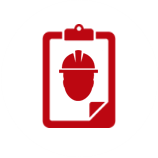
Resource Managers are the people with management authority over a Resource Pool. They are responsible to manage Team Members inside the pool. Resource Managers are on the supply side carrying out functions like hiring, professional development, training, incentive policies, leave management, absences, etc.
Team Member (TM)
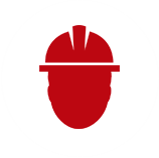
Team Members are the people who support the project manager in performing the work of the project to achieve its objectives. Team Members are on the supply side because they do the actual work in projects.
Jose Barato
Related posts
Categories
- Business (16)
- Demand Management Roles (14)
- Frequently Asked Questions (7)
- Guide (26)
- People (23)
- Assignments (2)
- Feedback (2)
- Project Team (3)
- Tracking Time And Expenses (2)
- Process (9)
- Closing (2)
- Executing And Controlling (2)
- Planning (1)
- Project Management (67)
- Management Frameworks (18)
- Organization Owner (OO) (3)
- Project Economy (54)
- Tools (19)
- Supply Management Roles (5)
- Training (6)
- Uncategorized (1)



